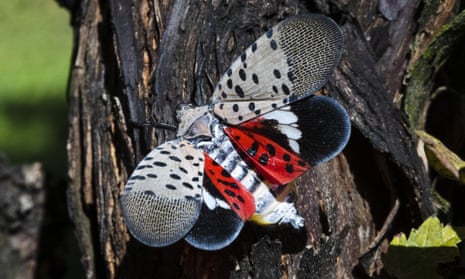The official public guidance is simple and to the point: “Kill it! Squash it, smash it … just get rid of it!”
Such is the threat posed by a summer invasion of troublesome spotted lanternfly insects in the north-east that Pennsylvania’s department of agriculture has resorted to the unorthodox language in its advice on dealing with the pest.
At least five states have reported infestations and four more have recorded the presence of the nuisance flying creatures, which experts say first arrived from China between seven and 10 years ago and which are currently feasting their way through the region on crops of apples, grapes and hops, and destroying native trees such as maple, walnut and willow.
According to the US department of agriculture’s invasive species information center, the insects – which can grow to about an inch in length and have an appearance similar to a moth – pose “a serious economic threat to multiple US industries, including viticulture, fruit trees, ornamentals and timber”.
As well as their destruction of plants, spotted lanternflies excrete a pervasive substance called honeydew that turns moldy and coats anything it comes into contact with, such as vehicles and children’s play equipment.
Pennsylvania is among the worst-affected states with 34 counties under a quarantine order, eight added for the first time this year.
Under quarantine rules, residents and businesses are prohibited from moving articles that may harbor the insects or their eggs, including landscaping materials, trees and plants, construction waste and pots, pallets and crates. The restrictions extend to outdoor items such as grills, furniture, fire pits and even mobile homes.
“The mold is harmless to people, however it causes damage to plants,” the Pennsylvania guidance says.
“In counties infested and quarantined for spotted lanternfly, residents report hundreds of these bad bugs that affect their quality of life and ability to enjoy the outdoors during the spring and summer months.”
State scientists say the pests are “a huge threat” to Pennsylvania’s agriculture industry, potentially impacting hundreds of millions of dollars of crops and hundreds of thousands of jobs.
In Rhode Island, where spotted lanternflies have not been previously recorded, authorities have reacted quickly to the sighting of a single insect in the city of Warwick.
“More than 800 acres of agricultural lands including vineyards, orchards and berry farms are at risk of being infested, so it’s critical that we take the necessary steps to detect and stop the spread of this invasive pest,” Cynthia Kwolek, spokesperson for the division of agriculture, said.
Anybody who spots one of the insects, which have gray forewings black spots and hind wings with contrasting red and black patches, is requested to contact state agriculture officials. Larger infestations are treated with insecticide.
“In the fall, these bugs will lay egg masses with 30-50 eggs each. These are called bad bugs for a reason, don’t let them take over your county next,” the Pennsylvania agriculture department statement said.
The Associated Press contributed to this report
